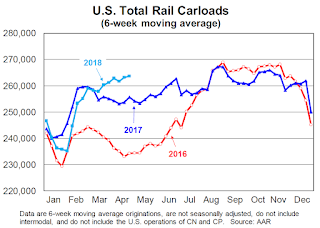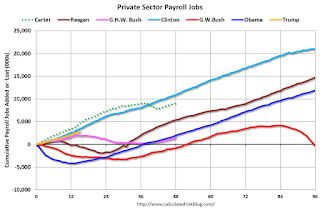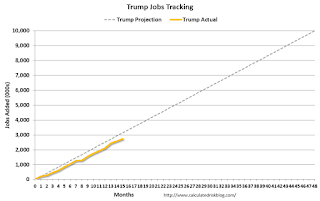by Calculated Risk on 5/05/2018 08:11:00 AM
Saturday, May 05, 2018
Schedule for Week of May 6, 2018
The key economic report this week is the Consumer Price Index (CPI) on Thursday.
3:00 PM: Consumer Credit from the Federal Reserve. The consensus is for consumer credit to increase $16.0 billion in March.
3:15 AM ET: Panel Discussion, Fed Chair Jerome Powell, Monetary Policy Influences on Global Financial Conditions and International Capital Flows, At the Swiss National Bank and International Monetary Fund High Level Conference on the International Monetary System, Zurich, Switzerland
6:00 AM: NFIB Small Business Optimism Index for April.
 10:00 AM ET: Job Openings and Labor Turnover Survey for March from the BLS.
10:00 AM ET: Job Openings and Labor Turnover Survey for March from the BLS. This graph shows job openings (yellow line), hires (purple), Layoff, Discharges and other (red column), and Quits (light blue column) from the JOLTS.
Jobs openings decreased in February to 6.052 million from 6.228 in January.
The number of job openings (yellow) were up 7.7% year-over-year, and Quits were up 6.3% year-over-year.
7:00 AM ET: The Mortgage Bankers Association (MBA) will release the results for the mortgage purchase applications index.
8:30 AM: The Producer Price Index for April from the BLS. The consensus is a 0.3% increase in PPI, and a 0.2% increase in core PPI.
8:30 AM ET: The initial weekly unemployment claims report will be released. The consensus is for 220 thousand initial claims, up from 211 thousand the previous week.
8:30 AM: The Consumer Price Index for April from the BLS. The consensus is for a 0.3% increase in CPI, and a 0.2% increase in core CPI.
10:00 AM: University of Michigan's Consumer sentiment index (Preliminary for May). The consensus is for a reading of 99.0, up from 98.8.
Friday, May 04, 2018
Oil Rigs: "Another solid week for rig additions"
by Calculated Risk on 5/04/2018 07:39:00 PM
A few comments from Steven Kopits of Princeton Energy Advisors LLC on May 4, 2018:
• Total US oil rigs were up, +9 to 834
• Horizontal oil rigs were up, +9 at 743
...
• The rig count saw widespread horizontal oil gains this week, including the Permian (+4) and Other US (+4)
• Notwithstanding, since last July’s peak, the Permian has added 75 horizontal oil rigs; all other plays together have gained only 10.
• Vertical oil rigs are at their lowest level since November 2016
• The Brent spread has eased back to just over $5 / barrel, but with the gap closing from below, suggesting that the US consumer is trying to hold on to domestic oil inventories. This pattern suggests continued upward price pressure.
 Click on graph for larger image.
Click on graph for larger image.CR note: This graph shows the US horizontal rig count by basin.
Graph and comments Courtesy of Steven Kopits of Princeton Energy Advisors LLC.
AAR: Rail Carloads Up 3.3% YoY, Best April Ever for Intermodal
by Calculated Risk on 5/04/2018 04:13:00 PM
From the Association of American Railroads (AAR) Rail Time Indicators. Graphs and excerpts reprinted with permission.
April was a very good month for U.S. rail traffic. Fifteen of the 20 carload commodity categories the AAR tracks saw higher carloads in April 2018 than in April 2017 — 15 is the most since January 2015. Total carloads were up 3.3% (34,020 carloads) in April ...U.S. intermodal volume in April 2018 was up 6.8%, or 69,630 units, over April 2017. April was the 15th straight year-over-year monthly increase for intermodal, dating back to February 2017. Average weekly intermodal volume in April 2018 was 274,750 units, the third highest for any month on record. April is the seventh straight month in which U.S. intermodal volume was the highest ever for that month.
 Click on graph for larger image.
Click on graph for larger image.This graph from the Rail Time Indicators report shows U.S. average weekly rail carloads (NSA). Light blue is 2018.
Rail carloads have been weak over the last decade due to the decline in coal shipments.
Originated U.S. rail carloads in April 2018 were up 34,020, or 3.3%, over April 2017 to 1.05 million. Total carloads have risen in three of the past five months. Weekly average carloads in April 2018 were 262,757, the most for April since 2015.
 The second graph is for intermodal traffic (using intermodal or shipping containers):
The second graph is for intermodal traffic (using intermodal or shipping containers):U.S. railroads originated 1,099,000 containers and trailers in April 2018, up 69,630 units, or 6.8%, over April 2017. It’s the 15th straight year-over-year monthly increase for intermodal, dating back to February 2017. Average weekly intermodal volume in April 2018 was 274,750 units, the third highest for any month on record (behind only February 2018 and October 2017). April is the seventh straight month in which U.S. intermodal volume was the highest ever for that month.
Early Q2 GDP Forecasts
by Calculated Risk on 5/04/2018 02:55:00 PM
From Merrill Lynch:
We revise down our 2Q GDP forecast to 3.2% from 3.7% as consumer spending and capex trends appear less bullish and there is a weak handoff between 1Q and 2Q. [May 4 estimate].And from the Altanta Fed: GDPNow
emphasis added
The GDPNow model estimate for real GDP growth (seasonally adjusted annual rate) in the second quarter of 2018 is 4.0 percent on May 3, down from 4.1 percent on May 1. [May 3 estimate]From the NY Fed Nowcasting Report
The New York Fed Staff Nowcast stands at 3.0% for 2018:Q2. [May 4 estimate]CR Note: These early estimates suggest GDP in the 3% to 4% in Q2.
Public and Private Sector Payroll Jobs During Presidential Terms
by Calculated Risk on 5/04/2018 12:15:00 PM
By request, here is another update of tracking employment during Presidential terms. We frequently use Presidential terms as time markers - we could use Speaker of the House, Fed Chair, or any other marker.
NOTE: Several readers have asked if I could add a lag to these graphs (obviously a new President has zero impact on employment for the month they are elected). But that would open a debate on the proper length of the lag, so I'll just stick to the beginning of each term.
Important: There are many differences between these periods. Overall employment was smaller in the '80s, however the participation rate was increasing in the '80s (younger population and women joining the labor force), and the participation rate is generally declining now. But these graphs give an overview of employment changes.
The first graph shows the change in private sector payroll jobs from when each president took office until the end of their term(s). Presidents Carter and George H.W. Bush only served one term.
Mr. G.W. Bush (red) took office following the bursting of the stock market bubble, and left during the bursting of the housing bubble. Mr. Obama (dark blue) took office during the financial crisis and great recession. There was also a significant recession in the early '80s right after Mr. Reagan (dark red) took office.
There was a recession towards the end of President G.H.W. Bush (light purple) term, and Mr Clinton (light blue) served for eight years without a recession.

The first graph is for private employment only.
Mr. Trump is in Orange (just 15 months).
The employment recovery during Mr. G.W. Bush's (red) first term was sluggish, and private employment was down 804,000 jobs at the end of his first term. At the end of Mr. Bush's second term, private employment was collapsing, and there were net 391,000 private sector jobs lost during Mr. Bush's two terms.
Private sector employment increased by 20,964,000 under President Clinton (light blue), by 14,717,000 under President Reagan (dark red), 9,041,000 under President Carter (dashed green), 1,509,000 under President G.H.W. Bush (light purple), and 11,907,000 under President Obama (dark blue).
During the first 15 months of Mr. Trump's term, the economy has added 2,723,000 private sector jobs.

The public sector grew during Mr. Carter's term (up 1,304,000), during Mr. Reagan's terms (up 1,414,000), during Mr. G.H.W. Bush's term (up 1,127,000), during Mr. Clinton's terms (up 1,934,000), and during Mr. G.W. Bush's terms (up 1,744,000 jobs). However the public sector declined significantly while Mr. Obama was in office (down 266,000 jobs).
During the first 15 months of Mr. Trump's term, the economy has added 5,000 public sector jobs.

After 15 months of Mr. Trump's presidency, the economy has added 2,728,000 jobs, about 397,000 behind the projection.
Comments on April Employment Report
by Calculated Risk on 5/04/2018 09:19:00 AM
The headline jobs number at 164,000 for April was below consensus expectations of 190 thousand, however the previously two months were revised up a combined 30 thousand. With the revisions, this was close to expectations.
Earlier: April Employment Report: 164,000 Jobs Added, 3.9% Unemployment Rate
In April, the year-over-year employment change was 2.280 million jobs. This has been generally trending down, but is still solid year-over-year growth.
Average Hourly Earnings
Wage growth was about as expected in April, however hourly wages for March were revised down. From the BLS:
"In April, average hourly earnings for all employees on private nonfarm payrolls rose by 4 cents to $26.84. Over the year, average hourly earnings have increased by 67 cents, or 2.6 percent."
 Click on graph for larger image.
Click on graph for larger image.This graph is based on “Average Hourly Earnings” from the Current Employment Statistics (CES) (aka "Establishment") monthly employment report. Note: There are also two quarterly sources for earnings data: 1) “Hourly Compensation,” from the BLS’s Productivity and Costs; and 2) the Employment Cost Index which includes wage/salary and benefit compensation.
The graph shows the nominal year-over-year change in "Average Hourly Earnings" for all private employees. Nominal wage growth was at 2.6% YoY in April.
Wage growth had been trending up, although growth has been moving sideways recently.
Prime (25 to 54 Years Old) Participation
 Since the overall participation rate has declined due to cyclical (recession) and demographic (aging population, younger people staying in school) reasons, here is the employment-population ratio for the key working age group: 25 to 54 years old.
Since the overall participation rate has declined due to cyclical (recession) and demographic (aging population, younger people staying in school) reasons, here is the employment-population ratio for the key working age group: 25 to 54 years old.In the earlier period the participation rate for this group was trending up as women joined the labor force. Since the early '90s, the participation rate moved more sideways, with a downward drift starting around '00 - and with ups and downs related to the business cycle.
The 25 to 54 participation rate decreased in April to 82.0%, and the 25 to 54 employment population ratio was unchanged at 79.2%.
The participation rate had been trending down for this group since the late '90s, however, with more younger workers (and fewer 50+ age workers), the prime participation rate might move up some more.
Part Time for Economic Reasons
 From the BLS report:
From the BLS report:"The number of persons employed part time for economic reasons (sometimes referred to as involuntary part-time workers) was essentially unchanged at 5.0 million in April. These individuals, who would have preferred full-time employment, were working part time because their hours had been reduced or because they were unable to find full-time jobs."The number of persons working part time for economic reasons has been generally trending down, and the number decreased in April. The number working part time for economic reasons suggests a little slack still in the labor market.
These workers are included in the alternate measure of labor underutilization (U-6) that decreased to 7.8% in April. This is the lowest level for U-6 since 2001.
Unemployed over 26 Weeks
 This graph shows the number of workers unemployed for 27 weeks or more.
This graph shows the number of workers unemployed for 27 weeks or more. According to the BLS, there are 1.293 million workers who have been unemployed for more than 26 weeks and still want a job. This was down from 1.322 million in March.
This is the lowest level since September 2007.
This is trending down, but remains a little elevated.
The headline jobs number was a little disappointing, however the previous two months were revised up. For the first four months of 2018, job growth has been solid averaging close to 200 thousand per month.
April Employment Report: 164,000 Jobs Added, 3.9% Unemployment Rate
by Calculated Risk on 5/04/2018 08:47:00 AM
From the BLS:
Total nonfarm payroll employment increased by 164,000 in April, and the unemployment rate edged down to 3.9 percent, the U.S. Bureau of Labor Statistics reported today. Job gains occurred in professional and business services, manufacturing, health care, and mining.
...
The change in total nonfarm payroll employment for February was revised down from +326,000 to +324,000, and the change for March was revised up from +103,000 to +135,000. With these revisions, employment gains in February and March combined were 30,000 more than previously reported.
...
In April, average hourly earnings for all employees on private nonfarm payrolls rose by 4 cents to $26.84. Over the year, average hourly earnings have increased by 67 cents, or 2.6 percent.
emphasis added
 Click on graph for larger image.
Click on graph for larger image.The first graph shows the monthly change in payroll jobs, ex-Census (meaning the impact of the decennial Census temporary hires and layoffs is removed - mostly in 2010 - to show the underlying payroll changes).
Total payrolls increased by 164 thousand in April (private payrolls increased 168 thousand).
Payrolls for February and March were revised up by a combined 30 thousand.
 This graph shows the year-over-year change in total non-farm employment since 1968.
This graph shows the year-over-year change in total non-farm employment since 1968.In April the year-over-year change was 2.280 million jobs.
The third graph shows the employment population ratio and the participation rate.
 The Labor Force Participation Rate was decreased in April to 62.8%. This is the percentage of the working age population in the labor force. A large portion of the recent decline in the participation rate is due to demographics.
The Labor Force Participation Rate was decreased in April to 62.8%. This is the percentage of the working age population in the labor force. A large portion of the recent decline in the participation rate is due to demographics. The Employment-Population ratio decreased to 60.3% (black line).
I'll post the 25 to 54 age group employment-population ratio graph later.
 The fourth graph shows the unemployment rate.
The fourth graph shows the unemployment rate. The unemployment rate declined in April to 3.9%.
This was below the consensus expectations of 190,000 jobs, however the previous two months combined were revised up by 30,000.
I'll have much more later ...
Thursday, May 03, 2018
Friday: Employment Report
by Calculated Risk on 5/03/2018 05:22:00 PM
My April Employment Preview
Goldman: April Payrolls Preview
Friday:
• At 8:30 AM ET, Employment Report for April. The consensus is for an increase of 190,000 non-farm payroll jobs added in April, up from the 103,000 non-farm payroll jobs added in March. The consensus is for the unemployment rate to decrease to 4.0%.
Fannie and Freddie: REO inventory declined in Q1, Down 30% Year-over-year
by Calculated Risk on 5/03/2018 04:17:00 PM
Fannie and Freddie reported results for Q1. Here is some information on Real Estate Owned (REOs).
Freddie Mac reported the number of REO declined to 7,718 at the end of Q1 2017 compared to 10,938 at the end of Q1 2017.
For Freddie, this is down 90% from the 74,897 peak number of REOs in Q3 2010. For Freddie, this is the lowest since at least 2007.
Fannie Mae reported the number of REO declined to 24,063 at the end of Q1 2018 compared to 34,551 at the end of Q1 2017.
For Fannie, this is down 86% from the 166,787 peak number of REOs in Q3 2010. For Fannie, this is the lowest since at least 2007.

Here is a graph of Fannie and Freddie Real Estate Owned (REO).
REO inventory decreased in Q1 for both Fannie and Freddie, and combined inventory is down 30% year-over-year.
There are still a number of properties in the foreclosure process with long time lines in judicial foreclosure states - but this is close to normal levels of REOs.
Goldman: April Payrolls Preview
by Calculated Risk on 5/03/2018 03:35:00 PM
A few brief excerpts from a note by Goldman Sachs economists Daan Struyven and Spencer Hill:
We expect a 180k increase in nonfarm payroll employment in April, slightly below consensus expectations for a 190k gain. Most labor market indicators decelerated somewhat, and we don’t expect a meaningful weather rebound (relative to trend).
... the unemployment rate likely fell to 4.0% in April. Average hourly earnings likely rose 0.2% in April, reflecting somewhat unfavorable calendar effects, and 2.6% over the past year. ...
emphasis added


